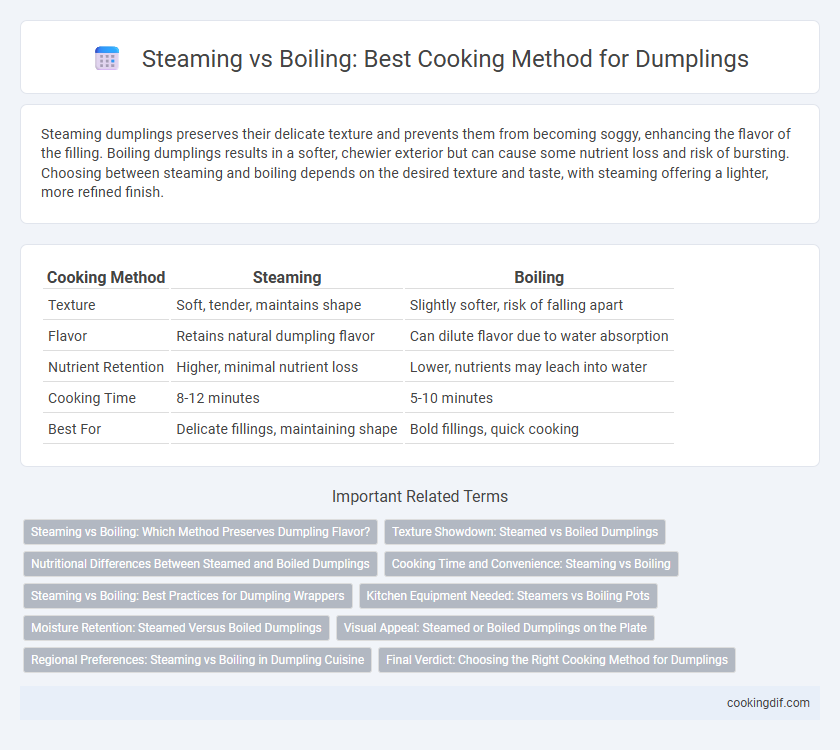Steaming dumplings preserves their delicate texture and prevents them from becoming soggy, enhancing the flavor of the filling. Boiling dumplings results in a softer, chewier exterior but can cause some nutrient loss and risk of bursting. Choosing between steaming and boiling depends on the desired texture and taste, with steaming offering a lighter, more refined finish.
Table of Comparison
| Cooking Method | Steaming | Boiling |
|---|---|---|
| Texture | Soft, tender, maintains shape | Slightly softer, risk of falling apart |
| Flavor | Retains natural dumpling flavor | Can dilute flavor due to water absorption |
| Nutrient Retention | Higher, minimal nutrient loss | Lower, nutrients may leach into water |
| Cooking Time | 8-12 minutes | 5-10 minutes |
| Best For | Delicate fillings, maintaining shape | Bold fillings, quick cooking |
Steaming vs Boiling: Which Method Preserves Dumpling Flavor?
Steaming dumplings preserves their delicate flavor and texture by cooking them gently with moist heat, preventing the loss of juices and maintaining a tender, slightly chewy outer layer. Boiling dumplings often causes some flavor dilution as they absorb water and may become soggy, diminishing the richness of the fillings. For optimal taste retention and texture, steaming is the preferred method to highlight the dumpling's authentic flavors.
Texture Showdown: Steamed vs Boiled Dumplings
Steamed dumplings have a tender, slightly chewy wrapper that retains moisture and enhances the filling's natural juiciness, resulting in a delicate, soft texture. Boiled dumplings feature a smooth, supple exterior with a firmer bite due to direct water contact, often yielding a more resilient and chewier texture. Texture enthusiasts often prefer steamed dumplings for their lightness and moist consistency, while boiled dumplings satisfy cravings for a slightly denser and more substantial mouthfeel.
Nutritional Differences Between Steamed and Boiled Dumplings
Steaming dumplings preserves more water-soluble vitamins like vitamin C and B-complex compared to boiling, which can cause nutrient leaching into the cooking water. Steamed dumplings also retain a firmer texture and a higher protein content due to minimal water contact. Boiling dumplings may reduce calorie density slightly but often results in a loss of essential minerals and antioxidants, impacting overall nutritional value.
Cooking Time and Convenience: Steaming vs Boiling
Steaming dumplings typically takes about 10-15 minutes and preserves their delicate texture, making it a convenient method when using a bamboo or metal steamer. Boiling dumplings generally requires 6-8 minutes, offering faster cooking time but sometimes resulting in a softer, less textured outer layer. Convenience varies as steaming demands a steamer setup and more attention, while boiling requires only a pot of boiling water, ideal for quick preparation.
Steaming vs Boiling: Best Practices for Dumpling Wrappers
Steaming dumpling wrappers preserves their delicate texture and prevents them from becoming soggy, providing a tender yet slightly chewy bite that enhances the filling's flavor. Boiling, while faster, can cause the wrappers to absorb too much water, making them overly soft and prone to tearing, which affects the overall eating experience. For optimal results, steaming at a consistent temperature using a bamboo or metal steamer lined with parchment paper or cabbage leaves ensures even cooking and prevents sticking.
Kitchen Equipment Needed: Steamers vs Boiling Pots
Steaming dumplings requires a bamboo or metal steamer basket paired with a pot or wok to generate steam, preserving delicate textures and flavors. Boiling dumplings demands a large pot filled with rolling water, allowing dumplings to cook evenly through submersion. Choosing the proper kitchen equipment ensures optimal heat distribution and dumpling quality.
Moisture Retention: Steamed Versus Boiled Dumplings
Steaming dumplings preserves moisture by gently cooking them with steam, preventing water from diluting the dough and fillings, resulting in a tender texture and juicier interior. Boiling immerses dumplings directly in water, which can cause some loss of flavor and moisture as water seeps into the dough and dilutes the filling. Steamed dumplings maintain a firmer, more flavorful bite, making steaming the preferred method for optimal moisture retention.
Visual Appeal: Steamed or Boiled Dumplings on the Plate
Steamed dumplings often boast a translucent, glossy skin that highlights intricate pleats, making them visually enticing on the plate. Boiled dumplings tend to have a softer, matte appearance with a smooth surface that showcases a plump, tender shape. Both methods create distinct textures and colors that enhance the dumpling's presentation and appeal in culinary settings.
Regional Preferences: Steaming vs Boiling in Dumpling Cuisine
Steaming is predominantly favored in Chinese cuisine, particularly in southern regions like Cantonese dim sum, where it preserves the dumpling's delicate texture and enhances freshness. Boiling is more common in northern Chinese and Eastern European dumpling traditions, such as jiaozi and pierogi, as it imbues the dough with a chewy consistency and allows flavors to meld during cooking. Regional preferences reflect cultural taste and ingredient availability, influencing the choice between steaming and boiling in dumpling preparation.
Final Verdict: Choosing the Right Cooking Method for Dumplings
Steaming dumplings preserves a tender, juicy texture while maintaining the delicate flavor of the filling, ideal for delicate wrappers and meat fillings. Boiling dumplings results in a softer, slightly chewier consistency and is perfect for thicker-skinned varieties or when cooking large batches quickly. Selecting the right method depends on the dumpling type and desired texture, with steaming favored for light, fluffy dumplings and boiling optimal for heartier, denser ones.
Steaming vs Boiling for cooking method Infographic

 cookingdif.com
cookingdif.com